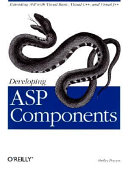
Developing ASP Components
By - Powers, Shelley , NetLibrary, Inc.
Floor
-
Floor 1
Published
-
O'Reilly, Sebastopel, CA, ©1999
ISBN 10 - 1565924460
ISBN 13 - 9781565924468
Book Status
-
1 Qnty Available with us.
Subject
-
Active server pages
Shelf No
-
7
Call no: 004.678 POW
Physical Description: xvii, 490 pages: illustrations; 24 cm.
Notes: Includes Bibliographical
References and Index.